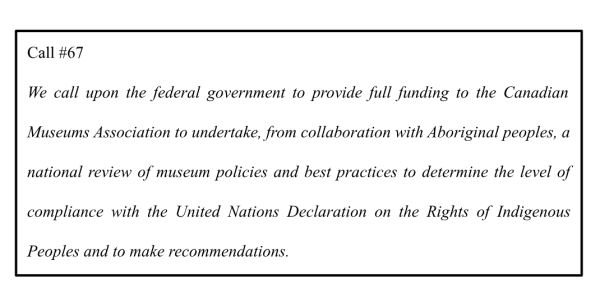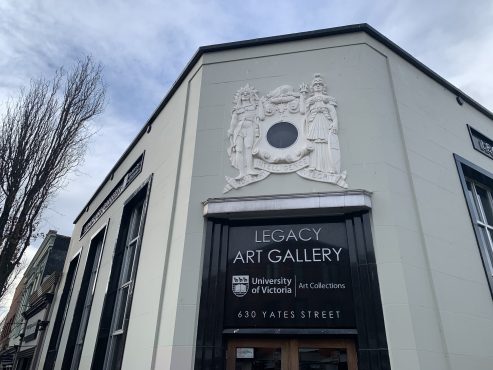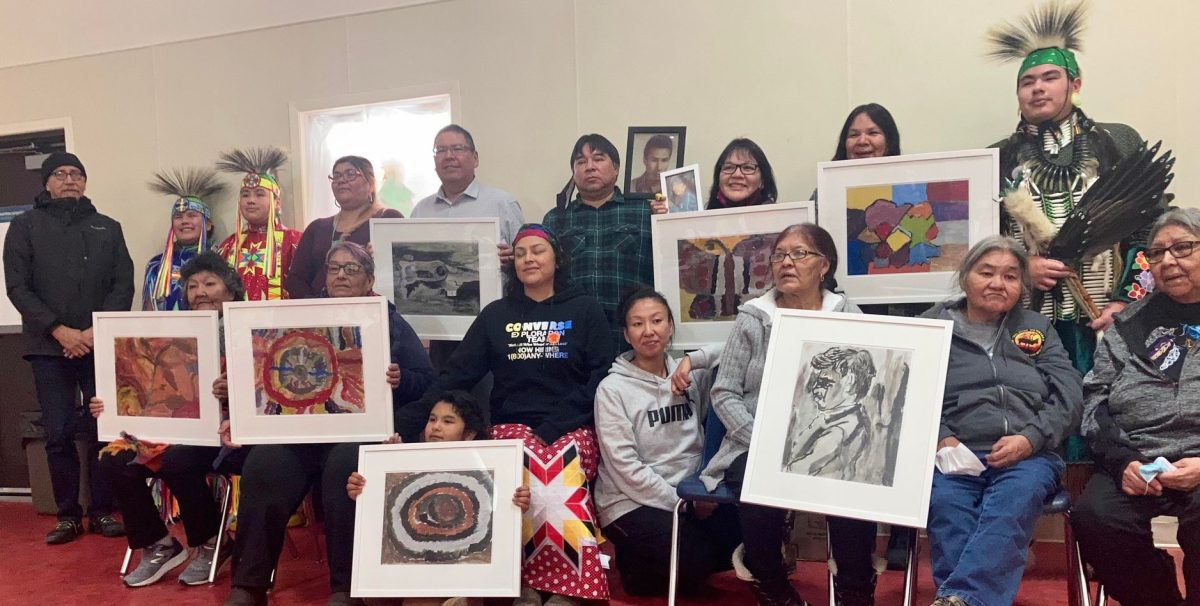“To hold it and examine it right up close — you can almost see how the weaver was weaving,” says Aay Aay, Haida artist and repatriation coordinator

Photo by Michael Vader.
Adrenaline pumped through Lorilee’s body as she prepared for what she thought would be a meeting full of tension. It was October of 2015, right after Orange Shirt Day, and she was in a room in the Cornett Building at the University of Victoria with her parents and an anthropology professor who she had never met.
The unveiling of a painting was about to take place. It was created by her father, Jim Wastasecoot, during his time at MacKay Residential School in Dauphin, Manitoba. He had not seen it since and had no idea what he had painted at just 10 years old.
The painting had arrived at UVic through her father’s art teacher Robet Aller, whose collection ended up at the university upon his death. Little did Lorilee know that this moment would be a central one in her career.
Today, Lorilee Wastasecoot is the curator of Indigenous engagement at UVic’s Legacy Gallery. She came into this role through the help of her mentor, Andrea Walsh, an anthropology professor — the same one who unveiled that painting. Together, the two women have worked to repatriate hundreds of lost paintings from residential schools across Canada. Now, Lorilee is working towards the repatriation of more items found in the Legacy Gallery’s collection.
In the past two years, UVic has begun the work of building a dedicated repatriation framework. This framework helps to facilitate the crucial and meticulous process of returning items to their homelands. The university is not alone in this journey — institutions across the province and beyond now have dedicated plans, policies, and procedures for repatriation.
The return of precious objects can have rippling effects on the communities whose items are returned, as they piece together the creations of their ancestors.

Repatriation is a term to describe the rightful return of Indigenous objects to their communities of origin, often from institutions that obtained them without consent. This concept has gained attention in B.C. recently, especially with the publishing of the Truth and Reconciliation Commission’s Calls to Action in 2015. In response to call #67, the Canadian Museums Association (CMA) released a 128-page document titled “Moved to Action”(MTA) in September of 2022, which details specific strategies and guidelines for museums to further their repatriation processes.
In many cases, repatriation has been unfolding at museums in B.C. for years, and this document is another aide in that process. At UVic, its release was another push forward in the creation of a repatriation framework.
Building a framework can mean different things at different institutions. UVic writing professor and volunteer member of the Legacy Galleries’ Collections and Acquisitions Committee, Lee Henderson, explained that repatriation was not always at the forefront of the group. He said that the main goal of the committee was to sift through donations and to work with artists and collectors interested in pitching pieces to join the collection.
The committee began to discuss repatriation efforts in November of 2021, and has steadily been planning its growth since then. Led by Wastasecoot, the team has begun identifying items to repatriate from the thousands of pieces in the collection.
“It’s quite a task, to research the provenance of all of these different objects and discover which ones may merit [repatriation],” said Henderson, adding that time and funding from the university are crucial in making this process as efficient as possible.
He also noted that the process is a careful one, which requires slow and delicate actions. “Every step should be meaningful, and [this] repair work can’t be superficial. If it takes a year to bring [an object] back to a community, that seems like very meaningful time spent.”
The release of the MTA may have been used as a catalyst for the start of this project at UVic and as an explanation for the importance of the work, but it is clear that repatriation has been on the minds of museum workers for far longer.
Wastasecoot explained that creating a support system has been the first step in building a dedicated repatriation framework at UVic. She said that the committee is Indigenous-led and emphasized that they are still in the beginning stage of the project.
“We are taking this very, very seriously,” she said. “We really want to start doing more of these types of repatriations, but it is a process that we want to do carefully and very thoughtfully.”
Repatriations often take a long time, according to Wastescoot. This is because of the thorough nature of the work and the number of Indigenous items in the collection.
“It’s a big process, but people have been doing this type of work for decades, and [proper repatriation] is not really an option anymore. We really need to get going on this work. We want to do it carefully, but we’re also [saying], ‘Let’s move this process along,’” she said.
Wastasecoot uses the term repatriation but prefers the “rematriation” when speaking about these efforts because of the process’ ties to women. “A lot of this work is led by Indigenous women.” She emphasised that the return of items is the final step in the process, but the process itself involves lots of care: relationship building, thoughtfulness, and “being aware of how these items have left and come back into the lives of Indigenous people.”
In July of 2023, UVic released its Institutional Accountability Plan and Report, which contains key information about efforts of reconciliation on and off campus. They explain that the university is “in the beginning stages of developing guidelines on how [to] care for its Indigenous art collection more respectfully, which may include rematriation / repatriation, and is developing guidelines for the commission and presentation of Indigenous art on campus.”

Photo by Hannah Link.
On top of this, the report highlights Wastasecoot’s role at the Legacy Gallery, and explains that her role as curator of Indigenous art and engagement was created to honour articles set out in the United Nations Declaration on the Rights of Indigenous Peoples (UNDRIP). Many of these articles call upon governments to allow Indigenous peoples the rights to maintain and interact with their cultures themselves.
UVic is far from the only post secondary institution that has been working on repatriation. At The University of British Columbia’s Museum of Anthropology (the UBC MOA), it has been a decades-long process.
The museum’s director, Dr. Susan Rowley, explained that she relies on the UBC-wide framework that sets out dedicated rules around Indigenous processes, much like UVic’s report. Rowley also sees UBC’s Indigenous Strategic Plan as another “critical component.”
In 2001, the MOA’s first formal repatriation policy was introduced and guided by UBC’s policies, specifically one titled “Deaccessioning Policy.” which outlines the university’s policy towards repatriation.
At the individual museum level, the focus of policies shifts to look more at specific measures that can respect each community in the best way possible. “We’re talking about reconciliation, reparation, return, restoring. We’re talking about health and wellness in communities,” said Rowley.
Rowley’s work has also been influenced by the CMA’s MTA. “[It’s] an incredibly valuable document that we all need to read and implement,” she said.
No policy changes have been made as a result of the document, partly because of its recent release and also because of an ongoing construction project at the MOA. Rowley looks forward to what the MTA can provide for her work going forward. “We take these policy documents really seriously, and the CMA Moved to Action is another in a suite of those important documents.”
At the Royal B.C. Museum (RBCM), respecting all angles of a repatriation journey is crucial. Janet Hanuse, vice president of engagement and declaration of rights on Indigenous Peoples Act (DRIPA) implementation, explained that this can often be a nuanced process.
One notable instance of repatriation at the museum was the return of a totem pole that belongs to the Nuxalk Nation, where differences between governmental and hereditary wishes caused some initial tension. According to museum records, the pole was purchased by a British ethnographer named Charles F. Newcombe in 1913 and brought to the RBCM to be displayed.
Located where the Bella Coola River meets the Pacific Ocean and tucked in between the Coast Mountains, Nuxlalk is a nation with thousands of years of history. Like many nations across the province, it has both a chief and council elected under the provisions of the Indian Act, and a hereditary chief chosen using traditional Indigenous governance systems.
Hanuse explained that the RBCM’s approach to repatriation has changed significantly in the past years, from one where only governments were involved to one where honouring hereditary wishes is a priority.
This was a crucial part of the repatriation process for the Nuxalk pole, because hereditary Chief Snuxyaltwa was at odds with the Nation about how the pole return should take place. The repatriation steps began in 2019, when Snuxyaltwa put in a request to have the pole returned.
The museum stepped out of the process to let the two come to a decision, and eventually asked the Nation to provide Snuxyaltwa with a Band Council Resolution (BCR) in order to resolve the issue. This would allow the Chief to work directly with the museum while maintaining the necessary legalities.
Hanuse explained that Snuxyaltwa was originally unhappy with the need for a BCR because he felt that traditional laws should supersede colonial ones.
“It took them a little while to arrive at their own agreement with that, and then they did,” she said. “The Nation [signed] a BCR to give us permission to speak directly with the Chief, and then we were able to begin our process with him.”
After years of logistics and formal approvals, the pole was ceremoniously removed from the museum and was returned home early last year after more than a century away.
Hanuse has only been in her role for just over a year, but she is passionate about repatriating in the most careful way possible.
“It’s scary because the colonial structures are structures that we have been dependent on our entire lives — including Chief Snuxyaltwa — everybody. None of us really know how to do this in this way, but we know how not to do it. We know what feels wrong.”
She also said that, though it is an important document, the principles in the CMA’s MTA are already “an innate practice.”
“I think that my approach actually deviates from the document [and moves] a little bit further towards self-determination,” said Hanuse, explaining that respecting hereditary law is of top priority for her.
At another university across the continent, repatriation has been taking place for nearly 30 years. Harvard University’s Peabody Museum of Archaeology and Ethnology is active in the United States repatriation scene, and has been involved with the return of Indigenous items from across the country.
Kara Schneiderman, director of collections, explained that the 1990 enactment of the Native American Graves Protection and Repatriation Act (NAGPRA) was critical to repatriation efforts at Peabody, but only within the United States.
“We had a repatriation program that was limited to NAGPRA compliance, but we had started to think beyond that,” said Schneiderman.
Last year, the Peabody Museum was involved in its first ever international repatriation. A totem pole from the Gitxaała Nation was returned in April after being held in Massachusetts since the end of the 19th century.
The community of Lax Klan sits on Dolphin Island, tucked in and amongst the larger islands that shelter the inside passage, across from Haida Gwaii. Just a two-hour boat ride away from Prince Rupert, most of its residents belong to the Gitxaała Nation.
Gitxaała lost its pole when it was sold to a collector from a New England fishing company, after having been cut into pieces by members of the Nation in order to hide its existence from Christian missionaries.
Dustin Johnson, language and culture manager at Gitxaała, said that the pole was once over 50-feet tall. “My ancestors saved this 12-foot section of it, and it was intentionally repurposed as an interior house post,” said Johnson. He also explained that the sale was made under duress during a time of colonial genocide.
“[The Gitxaała people] finally did [sell it] because of the pressure from the missionaries, because of our ‘heathen ways’ and ‘worshiping the devil’ and all of this religious propaganda,” said Johnson.
The pole arrived in Boston and was displayed at a local wharf named “T-Wharf.” Lights were crudely installed inside the pole so that the eyes of its animals glowed. The Boston Globe even published a story in 1906 that accused the pole of possessing “hoodoo” that wreaked havoc in the shipyard.
In 1917, the museum’s director C.C. Willoughby asked for the pole to be transferred to the Peabody Museum, and it was kept there until Glixaała contacted the institution in Spring of 2021.
Part of what allowed this repatriation to happen is the fact that the Peabody Museum has an extensive online record of the objects in their collection. When the Glixaała Nation set out to work on a dedicated repatriation project, they were able to use Peabody’s website to find the pole that they were looking for, said Meredith Vasta, collections steward at the museum.
“I really love that the Peabody has invested a lot of time and energy and resources into an online database for communities like them to use,” she said.
Vasta said she has worked at other museums where accuracy was put before speed when it came to having detailed collections online and available to the public.
“I was so happy that the Peabody was willing to have some spelling errors … just so that it’s out there,” she said. “People can search and find things, and I think that’s how these [repatriation] moments happen.”
When the pole arrived home, a feast was held for Glixaała Nation citizens to mark the important moment for the community.
“This project has really taken up a lot of my work, and we’ve had very [emotionally] challenging meetings,” said Johnson. “It’s a new thing for our people … applying our traditional law to bringing home our cultural treasures.”
The act of receiving back an item, whether it be a piece of art or literal ancestral remains, can bring up many emotions. Repatriation is not the simple return of an object, it is a conversation between people that can often leave Indigenous people with reopened wounds.
“It’s not all smiles and positivity — it brings back a lot of really dark things,” said Wastasecoot, adding that it is a process that requires care and compassion.
And repatriation means more to communities than just the return of an object. For many, the repatriation of pieces can allow them to further their careers in art, like Aay Aay who works as a repatriation coordinator at the Haida Gwaii Museum in Skidegate.
On top of his museum work, Aay Aay is a weaver who has benefited from holding repatriated objects. Most recently, the museum had a child’s robe returned back to the island.
“To hold it and examine it right up close — you can almost see how the weaver was weaving.” He says that by looking at pieces this way, many of which have been on hundred-year journeys around the world, artists like himself can further their practices and techniques.
James McGuire, the collections coordinator who works alongside Aay Aay, explained that the museum often hosts artists to interact with items in the museum so that they can study the pieces and learn from them. He’s also watched Aay Aay interact with these pieces and could see him absorb weaving information firsthand.
“His learning was expanded because he was able to touch items that either we visited in museums because of our relationships or that we repatriated,” said McGuire.
Through their work, Aay Aay and McGuire orchestrate the return of Haida items, but have also helped build a database for members of the community to learn more about themselves through the once lost objects of their ancestors.
“There is no bigger joy [than what] you see in peoples’ eyes when they realize that this museum is here for them to touch and hold their [ancestors’] things,” said McGuire.

Photo courtesy of Lorilee Wastasecoot.
Lorilee knows exactly what it is to hold her ancestors’ things. As a new student at UVic when she first saw her dad’s painting, Lorilee felt unsure of her place in the world. Far from home and farther from finding a path she wanted to follow, the project with Andrea helped her to carve her feelings into a career full of promise.
The painting that she was so nervous to see was in fact a painting of her father, surrounded by his parents and little sister. It was a snapshot in time, a glimpse of what was on his mind while he was away from his home, his family, and his culture.
For Wastasecoot, the unveiling was of more than just a painting. It was the unveiling of a world that she knew could turn pain and loss into power. And for thousands more across the continent, repatriation is only the beginning in a new era of Indigenous sovereignty.








